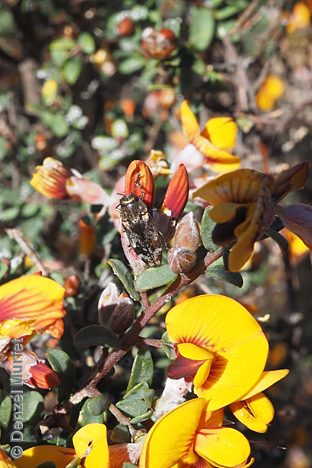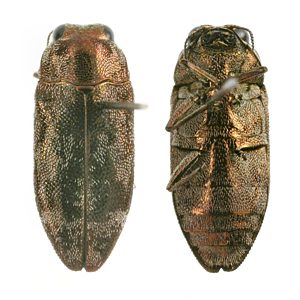Pronotum and elytra more or less concolouous throughout, coppery bronze with extensive irregular areas of whitish scale hairs. Anterior part of elytra prominently raised medially in vicinity of scutellum.
This is one of a small subset of Diphucrania species associated with native peas (family Fabaceae). In SA, it is confined to higher rainfall areas and does not appear to be particularly common here. The Mount Lofty Ranges and Kangaroo Island occurrences are outliers from the main populations in eastern Australia.
South Australian adult host records are mostly from Pultenaea species; in eastern Australia a wider variety of native pea genera and species have been reported.
Five matching larvae of the Agrilinae type were found in the swollen stem bases (galls) of a Dark Bush-pea Pultenaea viscidula on Kangaroo Island. The individual shown partly exposed in the images on this page was confirmed as Diphucrania acuducta based on its DNA barcode (mitochondrial CO1 sequence matching that of adults). This is the first breeding record of the species from Pultenaea.
There are two earlier records from NSW of this species breeding in other genera of native peas. Froggatt 1892 reported rearing D. acuducta (as Ethon marmoreum Laporte & Gory) from root 'galls' on Dillwynia retorta (as D. ericifolia). More recently, Turner & Hawkeswood 1995c reared an adult from within 'galls (or swellings)' on Bossiaea rhombifolia.
Froggatt described the galls thus: 'On the roots of several bushes of Dillwynia ericifolia, I found longer cylindrical swellings away from the base of the stem on the smaller roots which were found to contain beetle larvae, and .. the perfect insect. The galls are regular swellings of the rootlet, the young larva apparently eating round between the wood and the bark..'. He also mentioned 'a large oval gall on the roots close to the stem'.
| ¹ Legend | regions | SA State Herbarium regions (map)
EA: Eastern, EP: Eyre Peninsula, FR: Flinders Ranges, GT: Gairdner-Torrens, KI: Kangaroo Island, LE: Lake Eyre, MU: Murray, NL: Northern Lofty, NU: Nullarbor, NW: North-Western, SE: South-Eastern, SL: Southern Lofty, YP: Yorke Peninsula |
| size | The ellipse is the correct size when printed, indicative on a desktop screen, and likely to be wrong on a mobile device. |




 galls, KI, L1.5_x300.jpg)
 galls, KI, L2.5_x300.jpg)
 gall, KI, L3_x300.jpg)
 gall, KI, L4_x300.jpg)
 gall, KI, L5_x300.jpg)
 gall, KI, L6_x300.jpg)